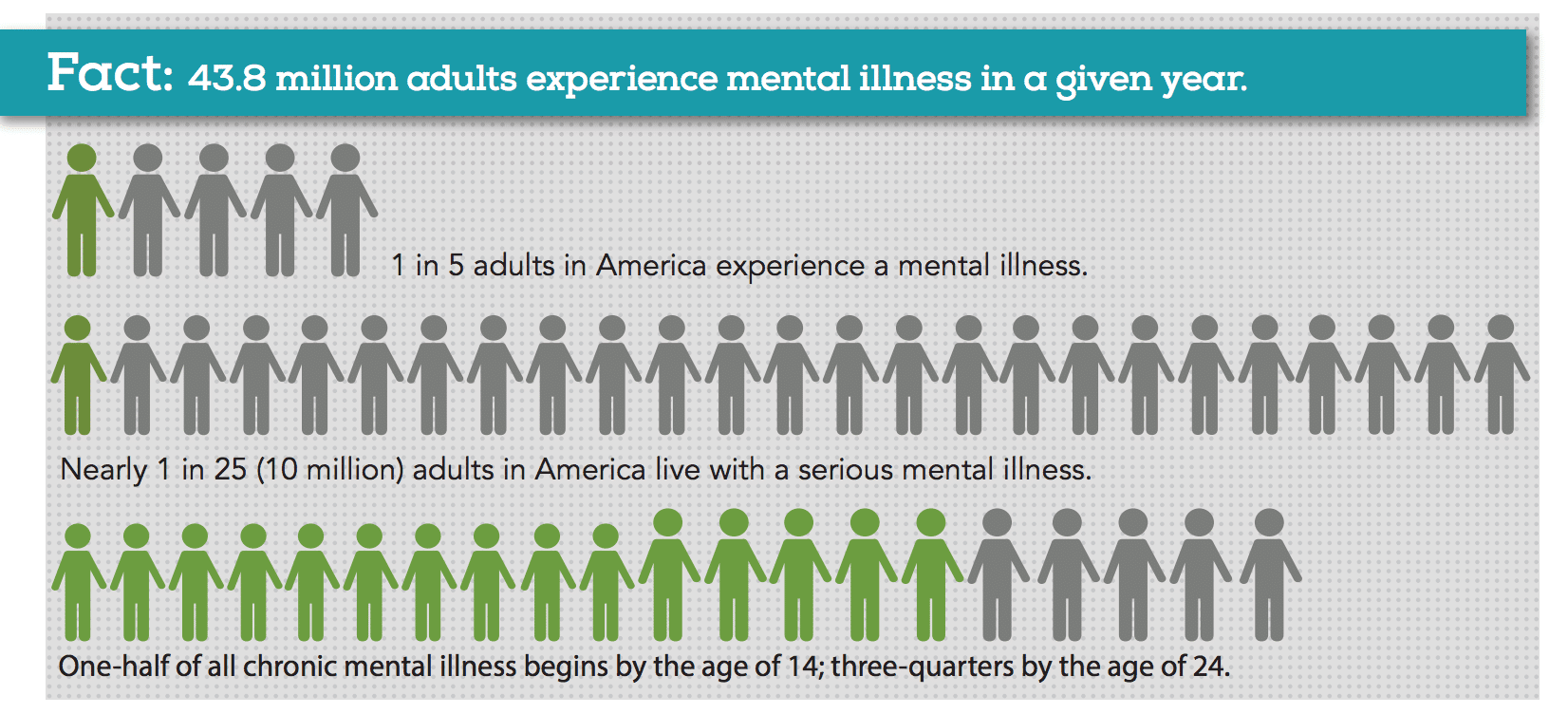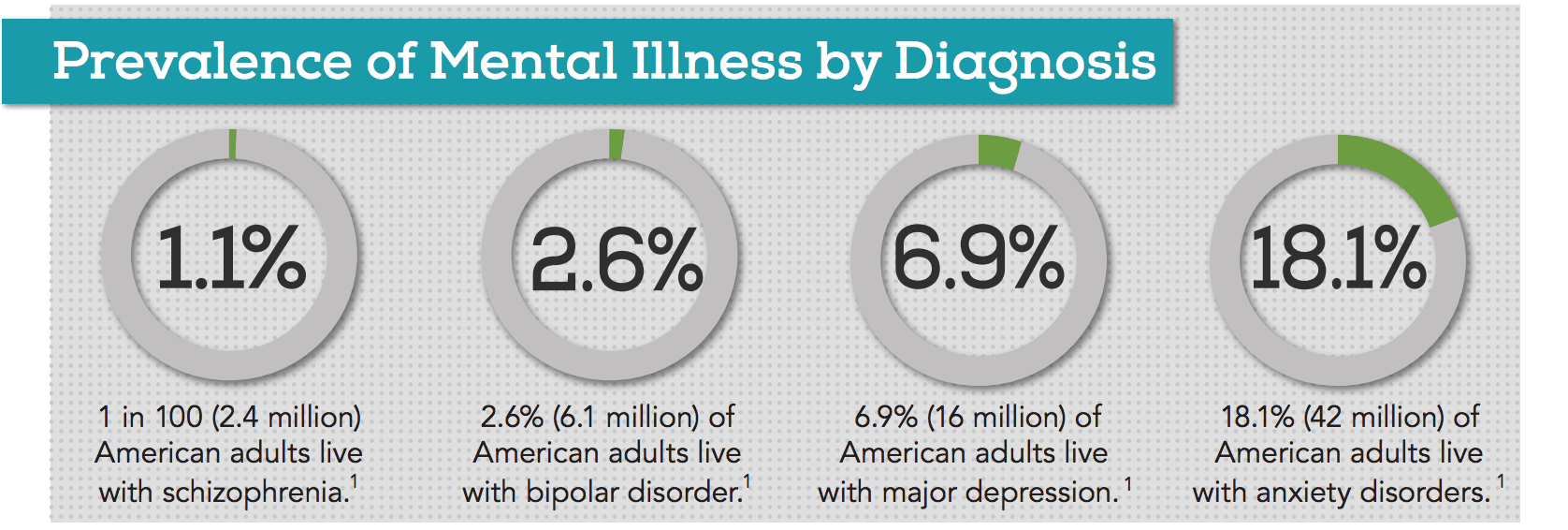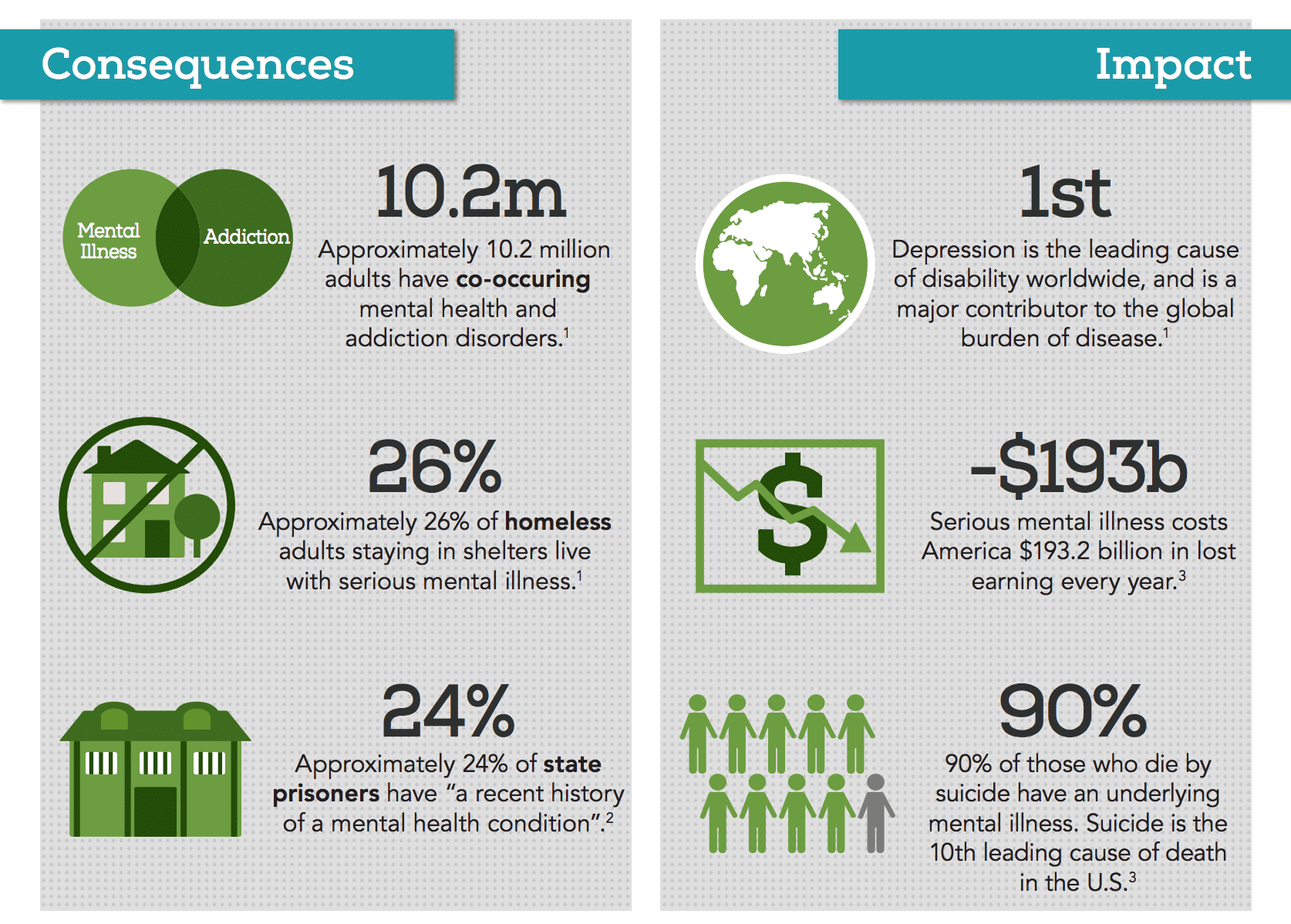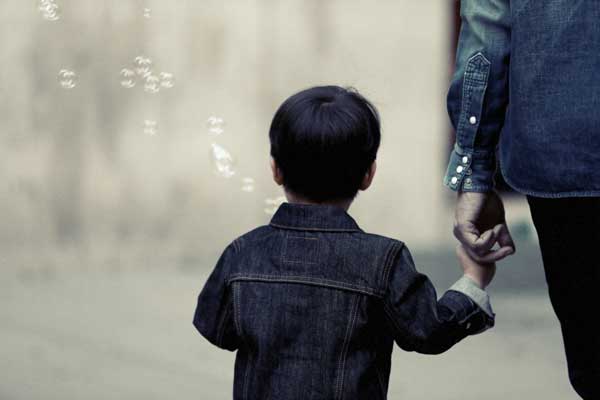Let’s talk about Mental Health Awareness. Sounds pretty basic, right? Discussing mental health is something that has often not been part of normal social protocol. In fact, in previous generations discussing mental status, personal health, and relationships were considered “taboo”. Over the past few decades, those former ideas of what is appropriate for discussion have faded and we have become a more connected society with social media, technology, and handheld devices ruling our world. The discussion on mental health among young adults is still something that has a stigma attached to it, but with 1 in 5 people being affected by mental health concerns in the United State, mental health awareness is becoming increasingly more important.

Photo provided by NAMI (National Association of Mental Illness) on New Roads Behavioral Health Blog – Mental Health Awareness
Prevalence of Mental Health Concerns in the United States
The National Association of Mental Illness (NAMI) has released statistics to help educate people on how common it actually is. Not only do nearly 20% of Americans experience mental health conditions but 1 in 25 live with a serious mental health conditions. About 2.4 million people in the US suffer from schizophrenia. That means that 1 in 100 people in the US are schizophrenic. These severe psychological conditions have a big stigma attached to them. With the proper treatment and medication, people affected by schizophrenia can lead a fulfilling life with the help of their support system but because of assumptions that those with this particular illness are “crazy” people are often afraid to have that label define them. Its those assumptions that lead to ignorance of what these kinds of conditions really are and how those that are affected by it life with it. It is important to recognize and understand the person behind the label.

Photo provided by NAMI (National Association of Mental Illness) on New Road Behavioral Health Blog – Mental Health Awareness.
As many as 6.1 million people in the US live with bipolar disorder, a major behavioral disorder that is associated with dramatic mood swings and major depressive episodes much like borderline personality disorder. A startling 16 million people in the US suffer from major depression. Many people are unfamiliar with symptoms like lack of motivation, low energy levels, loss of appetite, and feelings of low self-esteem that accompany major depression. That’s nearly 7% of the population suffering from those kinds of feelings as a result of depression. American adults living with anxiety disorders tip the highest statistic at 42 million. That means that 18% of American adults experience constant worry, fear of the future, shakiness, and racing heart rates.
Stress as a Factor
With those statistics in mind, it’s any wonder that the young adult generation nick-named “Millennials” are being called the “most stressed out” generation by articles in popular publications like Time Magazine. In this article, they state some startling statistics along with the mention that many young adults don’t address mental health.
In this particular publication, they cite a study conducted on 2,000 adults in the US. They were given a scale of 1-10 to rate stress levels. While the general consensus was that relative stress levels were declining over time, the young adult population scores did decrease as much as other age groups. Many people said that the cause of their stress levels stemmed from work, finances, and relationships. About half of those that were surveyed said that they didn’t have any support for managing their stress. Even though 32% of the adults said it was important to discuss stress management with healthcare providers, there was only 17% of them that actually did bring the topic of stress and mental health up at an appointment.
“Despite the fact that stress increasingly touches the life of almost every American, and that there are lifestyle changes that can help to relieve some of the worst aspects of stress, once in the doctor’s office, it’s not a common topic of discussion. About 20% report never talking to their provider about lifestyle changes to improve their health, 27% don’t discuss their progress in making behavior changes to curb stress, 33% never talk about how to manage stress and 38% never discuss their mental health.”
http://healthland.time.com/2013/02/07/the-most-stressed-out-generation-young-adults/
Consistent high stress can become a chronic condition. High blood pressure, depression, a weak immune system, heart disease, obesity and insomnia are just a few of the side effects of high-stress levels. Many people lack the proper education on what stress does and how it affects them. Adults often don’t talk about mental health with their healthcare providers and don’t get the treatment they need to manage stress and mental care appropriately. Those that ignore or don’t understand symptoms of depression, mental health concerns, and stress are more likely to suffer detrimental consequences that affect their life.
Consequences and Impact
The link between stress and mental state may not be direct, but there is a correlation between negative health and stress. Managing the mind can become more helpful when stress is minimized. Among those that suffer from mental health conditions, the rate of co-occurring mental health and addiction disorders is also worth mentioning. According to NAMI, 10.2 million adults in America suffer from both a mental health problem and an addiction disorder. This makes the practice of dual diagnosis in treatment programs of paramount importance when identifying problems with young adults especially with regard to substance abuse. By making mental health awareness a priority, we can help people that have co-occurring conditions or disorders.

NAMI Consequences and Outcomes of Mental Illness – New Roads Behavioral Health Blog on Mental Health Awareness
Stress, depression and anxiety are no little thing. They can cause major changes in mood. Living with depression alone can cause many problems in relation to health and negatively impact the immune system leading to more sick days from work. In fact, NAMI cites a loss of nearly $193 Billion lost in incomes each year due to mental health-related costs. As far as those living on the streets or homeless shelters, NAMI estimates that 26% of those people live with a serious mental health condition. In the prison system, 24% of prisoners have a history of mental health conditions.
The consequences of not managing mental health are extreme. Losing money, losing your home, losing your job, breaking the law and having severe medical problems are big issues. The impact of these situations has a harsh reality. Suicide rates studied in the United states makes it the 10th leading cause of death. Of those that die by suicide, it is estimated that the majority of them have an underlying disorder. With the death of the famous actor, Robin Williams, in 2014; the discussion on depression and suicide took on a new face. Considering that successful actors can also have problems, it made the call for more mental health awareness in our culture even more or a priority. Many people were effected by this tragedy and as a public figure, it helped to humanize the important topic of depression.
Finding Mental Health Help
Educating people on mental health and creating more mental health awareness can not only help people to find the right treatment, but it can also help release the stigma about mental health. Asking for help is the first step, and it is often the hardest step. Coming to terms with treatment can be very difficult, but in order to find the right tools to help live with psychological disorders, one must first find acceptance. Most people deny that they need help at first. But with the help of family and friends, often they can intervene and help people find recovery through competent and evidence based programs.
Spencer Palmer, a mental health therapist explains that one of the most common challenges for people entering residential treatment is often coming to terms with the fact that they need to be there. Finding help and accepting help can be very difficult when learning the skills necessary to live with a psychological disorder and recover from substance abuse. The recovery process is sometimes long and each individual is different. With the use of dual diagnosis, everyone has a unique experience when finding the right place to help with treatment and recovery.
“And yet shockingly, of the 450 million people worldwide who suffer from mental health conditions, the majority (60 percent) do not receive any form of care, with 90 percent of people in developing countries receiving no form of care.”
Micheael Friedman, PHD – Psychology Today Article
For those seeking mental health treatment, residential treatment is often the best choice. By surrounding themselves in an assertive community model, they are provided with enough support and resources to recover. Finding new skills to cope with daily tasks and different situations is important in establishing independence and learning how to integrate themselves into the real world outside of treatment. Many people that suffer from behavioral health issues or personality disorders (like borderline personality disorder), aren’t considered “sick enough” to get help from government-funded programs or disability. That is when residential treatment programs are the best option.
Mental Health Awareness Goes Mainstream
There are a few campaigns to help educate society and create mental health awareness. The Duchess of Cambridge, Kate Middleton, has penned an article calling attention to addressing mental health among the next generation. In her blog post written for the Huffington Post in the UK, she is quoted taking on this important topic:
“The mental health of our children must be seen as every bit as important as their physical health. For too long we have been embarrassed to admit when our children need emotional or psychiatric help, worried that the stigma associated with these problems would be detrimental to their futures. Research published today by the Huffington Post indicates that around a third of parents still worry that they will look like a bad mother or father if their child has a mental health problem. Parenting is hard enough without letting prejudices stop us from asking for the help we need for ourselves and our children.”
Kate Middleton quote on bustle.com article
Releasing the judgment of others will also quell the stigma about mental health. By showing her support and calling attention to the next generation, Middleton is helping pioneer a future that will help children understand the importance of being healthy in all aspects.
Mental health has also taken to the big screen with recent Oscar nods to a few movies like “What Happened, Miss Simone?”, “Amy”, “Inside Out”, “Love & Mercy”, “Infinitely Polar Bear” and “Welcome to me”. Showcasing some of the people that have suffered from mental health conditions and making their story relatable to a large group of people through movie making is helping to create an understanding of what mental health is really about. Becoming educated on the people surrounding the label can help humanize a very common human condition.
In the past, movies have also given mental health a bad name. Making the antagonist of fictional stories “mentally ill” created a stigma of fear in relation to mental health. Portraying psychological disorders as unpredictable and erratic creates a great deal of distrust of those with mental health problems. That fear leads to more social distancing. But there is another side to this as well. Pop culture with the “party” scene has also given a make-believe notion that substance abuse and experimentation with drugs and alcohol are more mainstream and less of a problem. In reality, many people that have substance abuse problems find that early innocent curiosity was the catalyst to a more severe problem because they thought it was socially acceptable and even expected. Many people experiment to “look cool” or seem like part of a group when they have felt isolated. In reality, those drugs or substances can end up distancing them from a healthy lifestyle and provide instability and trouble thinking clearly.
Addressing the Mental Health Stigma
Social distancing is a phenomenon that occurs when the stigma of mental health is present. Distancing psychological disorders is separating the “sick” from the crowd and keeping them under wraps because of fear. In recent studies by the World Health Organization (WHO) and the World Economic Forum (WEF), they cite mental health conditions as the biggest burden affecting economic situations world wide. The costs surrounding mental health care are projected to exceed $6 trillion by 2030. Loss in employment contributes to two-thirds of that estimate. Loneliness and isolation contribute to a huge deficit in mental health. A study conducted in Sweden of approximately 54,000 found that loneliness and isolation predicted mental health disorders.
Awareness is the most productive way to help. Discussion on how we can reach out beyond ourselves and surround people with support contributes to shattering the stigma surrounding mental health. Another campaign by NAMI is promoting the #IAmStigmaFree on social media. Those that contribute to this campaign pledge to:
- Learn more about mental health issues.
They are not the result of poor parenting or weakness. Mental health conditions are not a combination of symptoms, education about mental health helps correct false information. - See the person and not the illness.
Mental health disorders are more common than you know. Finding the person behind the label helps create empathy and understanding. - Take action on mental health issues.
Speak out and take an active role to support legislation that helps to improve our mental healthcare system.
https://www.nami.org/stigmafree
Finding help and supporting a long-lasting recovery is something that people fight for every day. The statistics of mental health conditions point to a very common problem that is often not addressed or misunderstood. Acceptance of the problem and then finding the right form of help can be the best part of the process but also very difficult. Living with a mental health condition is possible. Having a support system with people who care about you contribute to recovery and success. Looking for help for substance abuse, behavioral health, personality disorders, and long-term residential care is the best way to continue to improve mental health. The more we reach out and contribute, the more we’ll get back in return.
Eric Schmidt, CEO, and Founder of New Roads Behavioral Health discusses the keys to a healthy and balanced life:
New Roads Behavioral Health has made it their mission to provide enough hope for everyone involved in the recovery process. By providing mental health resources for a variety of residential and outpatient programs, we hope to help those that we work with learn the skills necessary to have a life worth living.
If you or someone you know would like to talk to one of our caring professionals, please call us today: 888-358-8998
Sources:
https://www.nami.org/NAMI/media/NAMI-Media/Infographics/GeneralMHFacts.pdf
http://www.nami.org/Blogs/NAMI-Blog/February-2016/Movies-in-2015-That-Showcased-Mental-Health
https://www.nami.org/stigmafree
http://www.bustle.com/articles/142560-kate-middleton-pens-article-about-mental-health-awareness-her-work-isnt-stopping-there
https://www.psychologytoday.com/blog/brick-brick/201405/the-stigma-mental-illness-is-making-us-sicker

